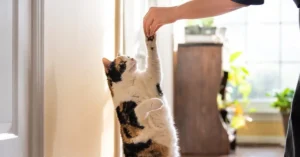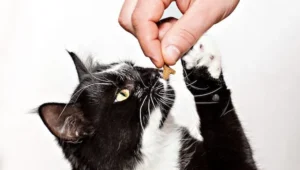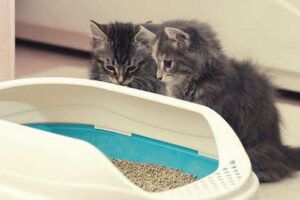Cats have been special for a long time because they are such good friends. When compared to dogs, they seem hard to train because they are independent and sometimes mysterious.
Table of Contents
Introduction
But, contrary to what most people think, cats can be taught to listen to orders and use a litter box if you are consistent and patient. In this complete guide, we will reveal cat training tactics and give you useful tips on teaching your cat how to use the litter box.
Understanding a Cat’s Mind

Before you start cat training, you need to know the basics about how cats act. Cats are different from dogs because they are both independent and protective of their territory at the same time. Dogs have been carefully bred for hundreds of years to obey human commands, but cats still have a stronger link to their wild past. This difference means that they need to be trained in a different way, one that fits with their natural habits and goals.
Cats use their body language, scent, and vocalizations to tell each other what they are thinking and feeling. Their strong sense of smell guides them through life, so they like to be in places where they can smell things they know. Also, cats have a natural desire to mark their territory and make safe places for themselves. A deep understanding of cat behavior will give you deep insights on how to train a cat successfully.
By understanding these complicated emotions, trainers can open up a cat’s ability to learn. Trainers can build relationships based on mutual understanding when they use a customized teaching method that takes into account their natural instincts and tendencies. In this way, the cat training process creates a bridge between the domestic and the wild, creating a place where cats can grow and enjoy working together with their human friends.
Importance of Positive Reinforcement
Positive reinforcement is the most important method for cat training. Positive reinforcement is the art of rewarding desired behaviors to encourage them to happen again. Punitive strategies, on the other hand, can cause stress and distrust. This method works well with cats because it builds a positive relationship with the teaching process and encourages a sense of cooperation.
During cat training, you can use a variety of rewards. Treats, warm affection, and sincere words of praise are three ways to get a cat to do what you want. These benefits act as a bridge between the behavior that is desired and the pleasure of a good result. The process becomes more than just training. It changes into a two-way exchange of knowledge in which the cat is an active partner.
But it’s important to remember that every cat has its own likes and dislikes. Just like cats have different personalities, they may also like different kinds of treats. This complexity shows how important it is to try new things. When you find the treat that makes your cat happy, the training setting changes into a place where you can give your cat personalized encouragement, and the promise of rewards becomes a driving force.
Positive reinforcement shows how important respect and kindness are when teaching. As the relationship between trainer and cat gets stronger, the journey turns into a dance where each small success is honored and each lesson learned is woven into a tapestry of shared growth. Through the lens of positive reinforcement, cat training goes beyond teaching and turns into a symphony of harmony between human and cat, written in the language of rewards and nourished by the chords of friendship.
9 Important Tips to Train Your Cat to Follow Commands
Training a cat to do what you want it to do can be fun and strengthen the bond between you and your pet. Even though cats are independent and it might seem hard, you can teach your cat to listen to commands with patience, consistency, and a deep understanding of how they act. Here is a full guide that explains every step of the process:
- Choose Easy Cat Training Commands

Start by choosing simple orders that are easy for your cat to understand. “Sit,” “Stay,” and “Come” are all good ways to start. As orders, use short, clear words instead of long phrases that might confuse your cat. These simple commands are the basis for more complex cat training in the future.
- Create a Positive Learning Environment

For successful cat training to take place, make sure there is a good setting. Choose a place that is quiet and comfortable for your cat. Keep your cat’s attention on the training job at hand by removing as many distractions as possible. By making your cat feel calm and safe, you make it more open to being trained.
- Give Rewards and Treats

Rewarding your cat is one of the most important parts of cat training. Have different kinds of your cat’s favorite treats on hand. When your cat does what you want it to do, reward it right away with treats and petting. This instant positive reinforcement connects the behavior to a pleasant result, which will encourage your cat to keep doing what you want.
- Reward Naturally Good Behavior

Cats often do what you want them to do naturally. Take advantage of these chances to teach the link between behavior and reward. For example, if your cat sits down on its own, give it a treat and praise it quickly. This keeps the behavior going and reinforces the idea that this action has good benefits.
- Vocalize the Cat Training Commands

Once your cat knows that the behavior is always followed by a reward, teach it the corresponding verbal order. For example, if you see your cat getting ready to sit down, say “Sit” right before they do. Over time, your cat will start to link the sound to the action and will eventually respond to the order itself.
- Be Patient and Consistent
 Patience is the key to successful cat training. Know that cats learn at their own speed and that their growth may be slow. Give daily short, focused training lessons, and make sure they stay interesting and upbeat. Consistency is very important. Giving orders and rewards over and over again reinforces the behavior you want over time.
Patience is the key to successful cat training. Know that cats learn at their own speed and that their growth may be slow. Give daily short, focused training lessons, and make sure they stay interesting and upbeat. Consistency is very important. Giving orders and rewards over and over again reinforces the behavior you want over time.
- Increase the Difficulty Level Gradually
As your cat gets better at following simple orders, you can gradually make them harder. For example, make the “Stay” word last longer before giving a reward. You could also teach your cat more complicated instructions, like “High Five,” which will test its intelligence. This gradual improvement gives your cat more control, which boosts their confidence and makes it easier for you to train them.
- Understand their Mind
To train a cat well, you need to understand what makes them act the way they do. Cats are driven by benefits and good things that happen to them. Dogs are pack animals that tend to seek praise, but cats are more independent and driven by their own needs.
You can tap into your cat’s natural desire for treats, affection, and comfort by using positive reinforcement methods. This fits with their natural tendencies and creates a setting where learning is fun instead of scary. Also, positive reinforcement helps you and your cat trust each other and work together, which builds a connection based on mutual respect and shared experiences.
- Overcome the Challenges

Cat training can be very rewarding but also difficult. Cats can be stubborn or not interested, and they often make mistakes. When meeting these kinds of problems, it’s important to stay calm and flexible. If your cat doesn’t react to a certain command, you might want to go back to an earlier step or change the way you’re training it. Every cat is different, and you can get great results from training them if you adapt your methods to their personalities and tastes.
9 Important Tips to Train Your Cat to Use Litter Box
Cat litter box training is an important part of owning a cat. It helps keep your home clean and makes life easier for both you and your cat. Cats are naturally driven to litter boxes because that’s where they put their waste. This makes it very important to set up the cat litter box correctly. In this in-depth guide to cat litter box training, we go over each step to make sure that your cat accepts the litter box as their chosen place to clean up.
- Choose the Right Cat Litter Box

Choosing the right cat litter box is the most important part of teaching a cat to use it. Cats have different tastes, so it’s important to choose a box that fits your cat’s size and interests. Some cats like closed boxes because they are more private, while others like open ones because they are easier to get into and can be seen. By making sure your cat is comfortable, you set them up for a good time in the litter box.
- Choose the Right Kind of Litter

There are so many kinds of cat litter that it can be hard to choose. Litter that clumps, doesn’t clump, has a smell, or doesn’t have a scent all have their own benefits. Seeing how your cat acts around different kinds of litter will help you choose the one they are most comfortable with. Comfort is important because cats have sensitive paws that get close to the litter box when they go to the bathroom.
- Choose the Right Spot
Choosing a good spot for the litter box is key to getting the cat to use it regularly. Choose a place that is quiet, easy to get to, and makes you feel safe. Avoid places with a lot of foot traffic and noise, as these can make cats not want to use the litter box. By putting the litter box in a good place, you can make your cat feel safe when they are feeling weak.
Note: There might be affiliate links mentioned here. We may receive a commission if you purchase a product through an affiliate link. There is no additional charge for you. Please do your own research before making any online purchases.
- Go for Slow and Gentle Introduction
When introducing kittens or new cats to the litter box, the process should be slow and gentle. After your cat eats, plays, or sleeps, gently lead them to the litter box. Cats naturally want to go to the bathroom after playing or eating, so this is a good time for them to get used to the designated place. Over time, this practice helps set up a regular schedule for going to the bathroom.
- Create a Positive Impression of the Litter Box
It is very important to get your cat to like the litter box. Accidents can happen when the cat is first learning, but yelling at it won’t help. Instead, make your cat feel good by giving it a treat when it uses the litter box properly. Your cat will feel like he or she has done something good when you give them treats or show them love.
- Keep the Box Clean

Keeping the cat’s litter box clean is one of the most important parts of training a cat. Cats are more likely to use a clean box, and a box that hasn’t been cleaned in a while can discourage them. Pick up your cat’s waste often to keep it from smelling bad and making you uncomfortable. Also, changing the litter and cleaning the box regularly keeps germs from building up and keeps your cat clean.
- Always Monitor Bathroom Habits for Signs of Danger
A sudden change in the way a cat uses the litter box can be a sign of a health problem. If your cat suddenly stops using the litter box or acts strangely, you need to take it to the vet right away. These changes could be early signs of urinary tract infections, kidney problems, or other health problems that need to be taken care of right away.
- Understand the Cat’s Mind
Understanding the psychological aspects of cat litter box training helps the process go more smoothly. Cats have a natural need to keep things clean and mark their territory. A clean litter box meets both of these needs by giving cats a private place to go to the bathroom and reducing the amount of waste in their area.
- Overcome the Challenges
Cat litter box training can be challenging, especially if your cat starts to dislike the litter or spot you choose. If your cat doesn’t want to use the litter box, try using different litters or moving the box. The most important thing is to be patient. Even small changes can lead to good results over time.
FAQs
Why is it important to know how cats act before starting cat training?
It’s important to understand how cats behave because that lets you tailor training to their natural habits, which leads to better cooperation and more successful training.
How do cats show how they feel and what they think?
Cats express themselves through their body language, scent, and sounds, which tell us about their feelings, likes, and dislikes.
What is the role of positive reinforcement in cat training?
Positive reinforcement means giving cats rewards when they do what you want them to do. This makes cats associate training with good things and makes them more likely to do those things again.
During cat training, what kinds of rewards can be used as positive reinforcement?
Treats, verbal praise, and affection are all good ways to treat a cat because they meet its needs and reinforce good behavior.
Why is it important to put a cat litter box in the right place?
Cats will feel safe and comfortable using the litter box if you put it in a good, quiet, and easy-to-reach place.
How do I know what kind of litter is best for my cat?
Different cats like different kinds of litter. Seeing how your cat acts around different litters will help you choose the right one.
Can I put scented litter in the cat litter box for my cat?
Scented litter might be nice for people, but it might be too much for some cats. It’s important to pick a litter that your cat is comfortable with.
How can I get my cat to think of the litter box in a positive way?
Giving your cat treats and petting them when they use the litter box right makes a positive link and encourages them to keep doing the same thing.
Why is it important to make sure the litter box is always clean?
Cats like clean litter boxes. Regularly scooping and cleaning the box gets rid of odors and makes sure your cat keeps using it.
What should I do if my cat stops using the litter box all of a sudden?
Sudden changes in how your cat uses the litter box could be a sign of health problems. Talk to a vet to make sure that your cat’s behavior isn’t caused by any health issues.
Conclusion
Cats have a reputation for being hard to train, but they can be taught to use a litter box and follow orders. For successful cat training, you need to know how cats act, use positive rewards, and be patient. Whether you’re teaching your cat training commands or how to use the litter box, keep in mind that every cat is different, and the way you train each one may be different. By training your cat with understanding and a willingness to learn from it, you can build a strong bond and a peaceful place to live for both of you.












